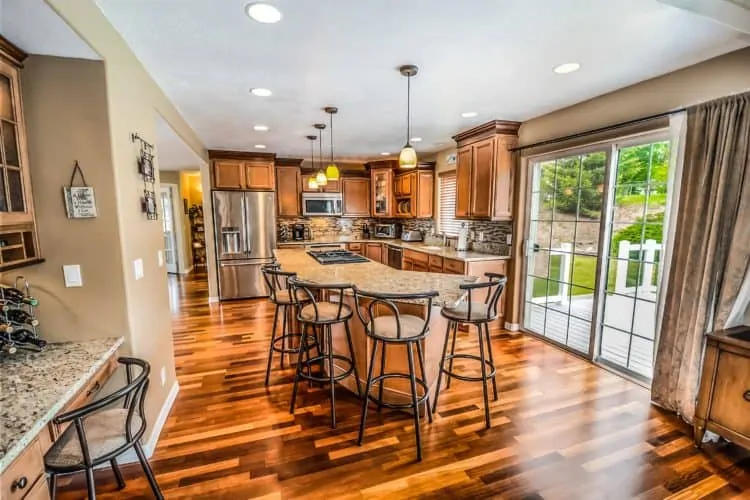
Choosing The Best Kitchen Flooring Options: A Guide
If you’ve chosen to redo your kitchen floors, the great news is, you have a ton of options to choose from. But that variety of choices can definitely prove overwhelming! Here are our recommendations for the best flooring options for kitchen remodels, with an overview of the pros and cons for each.
What Should I Look For in Kitchen Floors
Before we dive into the numerous options of floors for kitchens, it may be helpful to understand some of the key consideration factors for your kitchen remodel, as well as mistakes to avoid.
Water-Resistant or Waterproof
Considering that a lot of cooking, cleaning and general messiness happens in the kitchen, water-resistance or, even better, waterproofing is a key consideration in weighing your floor options. “Water-resistant” on the label is essential, otherwise you’ll spend just as much time wiping liquids off your kitchen floor as you will actually using it. If you want to go a step further and you’re going to invest in a room with waterproof floors, the kitchen (or bathroom) is a good place to do it.
Durable
Kitchens are full of appliances, pots, pans, cookware, and lots of other heavy items. Investing in a floor that’s durable and will withstand moderate drops and cookware tumbles is necessary. For this reason, it’s better to opt for an extremely durable floor, that is more resistant to scrapes, scuffs, and gouges from dropped kitchen materials.
Comfort
For many of the same reasons as listed above, choosing a floor that’s slightly softer may save the lives of many plates and coffee mugs that may suffer an unfortunate slip. If you opt for an extremely hard floor, you’re likely to see more kitchen casualties.
Safety
By nature, your kitchen will see a lot of movement. Combine moving bodies with a pretense for spills and liquid on the floor and counters, and kitchens present a potentially unsafe situation. Doing your research on your new kitchen floor safety factor (such as slickness) will help create a safer space.
Style
Take it from HGTV and choose floors that complement your kitchen, whether it’s rustic and country-style or cutting-edge contemporary. “Consider the kitchen’s size, as well as existing colors, textures, and patterns. Should the large surface underfoot serve as a neutral backdrop or a vivid focal point?”
Popular Types of Kitchen Floors
Below we’ll review some of the most popular types of kitchen floors, as well as reasons to choose or not choose each one.
Engineered Wood Floors
A kitchen floor trend that has grown in popularity in recent years in engineered hardwood. Here’s everything you need to know about this flooring option for kitchens.
What is Engineered Hardwood?
Engineered hardwood is a variation of true hardwood, but only the top and bottom layers of the material consist of real wood. The inner layers are made of plywood, high-density fiberboard or, sometimes, actual hardwood. The top layer is usually hardwood veneer, but can also be composed of true hardwood.
Engineered Hardwood Benefits
Engineered hardwood is especially good at handling moisture and dampness, which is why it’s very common for below-grade installations, like basements. It is very stable and versatile, especially compared to softer options, like laminate flooring.
In addition, engineered hardwood has the advantage of being easy to maintain, as well as a more affordable flooring choice. Since engineered hardwood flooring requires only a thin slice of the desired wood as the top layer, the cost is less than solid hardwood, but looks virtually the same.
Engineered Hardwood Drawbacks
While engineered hardwood is cheaper than solid hardwood, it’s not cheaper than laminate or carpet, so it’s not the most affordable kitchen flooring option out there. In addition, you have to be extra careful with your brand selection – some veneers are poorly made and can prematurely warp or fade. Furthermore, some manufacturers try to cut corners by using fiberboard, which could compromise the stability of your floor.
Tile Floors
Perhaps one of the most classic trends for kitchen floors, and one of the most long-standing options is tile floors. Here’s why this option typically ranks among the best flooring for kitchen remodels.
What Are Tile Floors?
Tile flooring is a natural choice for kitchens because it’s durable, water-resistant, and easily keeps stains at bay. Plus, there are so many options within the tile flooring world that it’s incredibly easy to find the exact look you desire for your kitchen.
Types of Tile Flooring
Kitchen floor tile comes in three types: porcelain, ceramic and stone. Prices of each type run the gamut, from $2 to $100 per square foot.
Porcelain tile carries the added benefit of being “certified” as porcelain. It also has an incredibly low water absorption rate. It is one of the most durable tile options because “porcelain clays are denser and thus less porous than ceramic clays,” which makes porcelain tile harder and more impervious to moisture than ceramic tile. Ceramic tile floors are slightly softer than porcelain, and also tends to be a slightly cheaper option.
Natural stone tile is produced from natural materials that are quarried, slabbed, finished, and cut to size. Common types of stone used as flooring tile include granite, marble, limestone (including travertine), and slate.
Tile Floor Benefits
Tile floors are a great choice for kitchens because they can withstand heavy foot traffic, water, spills and they don’t absorb odors or bacteria, which makes tile floors one of the most hygienic kitchen floor options. And in addition to there being thousands of styles of tile flooring to choose from, you can also add another layer of customization to your home, since tile can be arranged in a multitude of patterns.
Tile Floor Drawbacks
The hardness that makes tile so desirable as a kitchen floor surface can also be a drawback. People who spend a lot of time in the kitchen will want to put down floor mats or rugs since standing on tile for long periods of time can be tough on the body. In addition, tile is sure to be cold on brisk winter mornings, and the hard surface will not be forgiving on any dropped items.
Vinyl Flooring
Accounting for around 15% of annual flooring expenditures in the country, vinyl flooring has become an increasingly popular floor choose for homeowners, and it’s easy to see why.
What Is Vinyl Flooring?
Vinyl flooring was originally invented in the 1930s following World War II, and by the 1950s had become a major competitor against other flooring options, specifically linoleum.
Types of Vinyl Flooring
There are three major types of vinyl flooring: sheet flooring, tile flooring, and plank flooring. With sheet vinyl flooring, the vinyl flooring material is laid down in sheets that can range from 6 or 12 feet wide. Due to the larger pieces, sheet flooring is more water-resistant than other types of vinyl flooring. It also is easier to install.
Another type of vinyl flooring is tile flooring, which uses tiles of 9×9” or 12×12″. Many homeowners prefer vinyl tile, which replicates the look of a ceramic tile floor at a more affordable cost.
The last type of vinyl flooring is vinyl plank flooring, which has become an increasingly popular option. Vinyl plank flooring is designed to resemble hardwood, and comes in strips. One of the advantages of plank flooring is the range of styles that are out there for homeowners to choose from, all mimicking different types of wood, but without the large price tag.
Benefits of Vinyl Flooring
One of the biggest draws of vinyl flooring is the durability – specifically its resistance to water. Most vinyl flooring is 100% moisture-resistant. In addition, vinyl flooring is wildly affordable. When it comes to cost, vinyl is one of the most affordable flooring options out there, especially compared to options like stone, tile or hardwood. At the low range, vinyl can cost as little as fifty cents per square foot, and most never exceed moderate cost levels.
Vinyl is also very durable as well as relatively easy to maintain. If well-taken care of, your vinyl floors can last anywhere between 10 and 20 years.
Drawbacks of Vinyl Flooring
Because vinyl products are so soft, they have tend to warp to any particles left beneath them during installation. For example, a trapped bit of dirt could eventually become a bump in your vinyl floor. This means that homeowners need to be extra cautious in the installation process, and do a significant amount of prep work.
And although vinyl is durable, it is not impossible to damage – dropping sharp knives or other heavy objects in your kitchen is likely to leave a mark.
Luxury Vinyl Flooring
Luxury vinyl flooring is one of the fastest-growing flooring types in the world right now — it is a modern, beautiful, durable and affordable flooring solution that can stand against some of the most expensive flooring options out there.
What Is Luxury Vinyl Flooring?
Luxury vinyl flooring bears some similarities to regular vinyl flooring, but “luxury” vinyl flooring (LVF) differs from standard vinyl flooring in its ability to closely mimic the look of natural materials, such as wood or stone.
Typically luxury vinyl flooring is thicker than other types of vinyl flooring, and looks much more realistic in its resemblance to classic hardwood. It accomplishes this resemblance with a surface layer that has a very realistic photo-created image of real wood, combined with textures that resemble that of the real materials.
Types of Luxury Vinyl Flooring
There are a few specific types of luxury vinyl flooring. One of the most popular options is Luxury Vinyl Tile (LVT), which has a wide range of design options, and can replicate the look of natural stone or wood flooring, without the extensive installation or maintenance costs associated with either.
Another popular type of luxury vinyl is Luxury Vinyl Plank (LVP). As the name implies, Luxury Vinyl Planks look like planks of hardwood floors, especially since they are individual pieces of vinyl, not sheet vinyl.
There is a subset of Luxury Vinyl Plank called Engineered Vinyl Plank (or EVP). EVP is incredibly durable, and has a realistic hardwood look and feel. Perhaps the biggest differentiator of EVP from other vinyl or floor types is that it is waterproof.
Benefits of Luxury Vinyl Flooring
Arguably the biggest “pro” of luxury vinyl flooring is that with it, you can achieve a near-perfect hardwood look for a fraction of the cost – the average hardwood floor costs between $8-$25/square foot, while luxury vinyl costs around $2-$5/square foot.
While vinyl flooring offers the clear benefit of being water-resistant, only luxury vinyl flooring can offer the added benefit of being completely waterproof. For this reason, engineered luxury vinyl is a great selection moisture-prone areas in the home, such as kitchens, bathrooms, laundry rooms and mudrooms.
Luxury vinyl flooring, specifically engineered vinyl planks, are much more comfortable on your feet than other cheaper options. Plus it carries the added benefit of both temperature and sound insulation, so you won’t have to worry about cold winter floors or extra loud footsteps.
Cons of Vinyl Flooring
While vinyl flooring is low maintenance and highly durable, as with any product, there are a handful of “cons” to be aware of. For example, like regular vinyl flooring, luxury vinyl flooring is durable but not impossible to damage. Perhaps the biggest loophole to be aware of is that, despite the name of the product, luxury vinyl flooring won’t improve the value of your home in the same way that hardwood or tile does.
Cork Flooring
For those prioritizing comfort in their kitchen floor selection, cork is a great option.
What Is Cork Flooring?
Cork is “harvested from the bark of the cork oak tree—a beech relative that grows primarily in the Mediterranean. The material is ground, mixed with resins, and cut into floors. Cork flooring straddles the line between resilient and engineered floor categories”.
Benefits of Cork Flooring
Cork is the most comfortable kitchen floor choice. Its inherent softness and springiness make standing for long periods much easier on backs, legs, and feet. And, if you drop a glass or coffee mug, they are less likely to shatter on cork than on other, harder surfaces.
In addition, cork works as a natural insulator – not only is it warmer under foot than other flooring choices, but it also muffles sound and helps to reduce energy bills. This quality makes cork a great floor selection for large family homes.
Drawbacks of Cork Flooring
While cork flooring comes in a variety of styles and colors, there is slightly more limited array than with other popular flooring choices, like luxury vinyl. Also, cork flooring is susceptible to fading, especially when placed in the path of direct sunlight. For this reason, many homeowners elect to have their cork floors refinished every few years. This quality, in combination with the fact that cork floors must be kept free of dirt and sand (since they can scratch the surface over time), make core flooring more high maintenance than some other flooring options.
Cork flooring is also not sustainably waterproof, which makes it a difficult choice for the kitchen – it must be sealed every 5 years to keep it water resistant.










